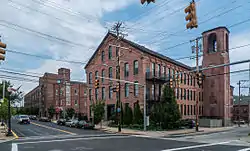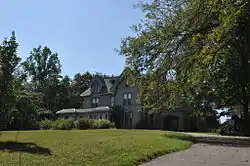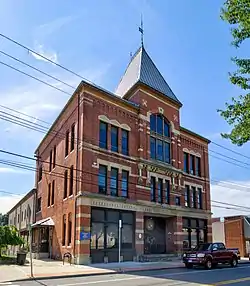William Russell Walker | |
|---|---|
 | |
| Born | April 14, 1830 |
| Died | March 11, 1905 (aged 74) |
| Alma mater | Scholfield's Commercial College |
| Occupation | Architect |
| Spouse | Eliza B. Hall |
| Practice | William R. Walker & Son Walker & Gould |
| Buildings | Robinson Hall, Equitable Building, Northbridge Memorial Town Hall |

William R. Walker (April 14, 1830 – March 11, 1905) was an American architect from Providence, Rhode Island, who was later the senior partner of William R. Walker & Son.
Early life
Major-General William Russell Walker was born on April 14, 1830, in a part of Seekonk, Massachusetts that is presently part of East Providence, Rhode Island, to Alfred and Huldah Walker. He attended the public schools, and graduated from the Seekonk Classical Seminary in 1846. For three years he was a builder's apprentice in Providence, and studied architectural drawing at Scholfield's Commercial College in his free time. In 1850 he went to Augusta, Georgia, but returned to Pawtucket the following year, where he would live for the rest of his life. In 1861 he was commissioned first lieutenant of Company E of the 1st Rhode Island Detached Militia. The regiment mustered out three months later in August.[1]
Architectural career
In 1864, Walker established himself as an architect in Providence's Merchants Bank Building,[1] moving to the Reynolds Building (37 Weybosset) by 1871.[2] In 1874 his son, W. Howard Walker, entered the office as a student and draftsman.[3] Walker practiced alone until January 1876, when he made Thomas J. Gould, draftsman since 1868, partner in Walker & Gould.[4] In about 1878, Walker & Gould moved into their new Vaughan Building, on Custom House Street. Walker & Gould was dissolved as of January 1881, and the Walkers formed a new firm, William R. Walker & Son. Gould established Gould & Angell with Frank W. Angell, another Walker draftsman. During the 1880s to 1890s, Walker & Son grew to become one of the state's largest firms.
Walker continued in his position as senior partner until his death in 1905. His son (died 1922) and grandson (died 1936) each operated the firm until their deaths.[5]
Personal life
In 1852, Walker married Eliza B. Hall, who died in 1895. They had two children, George Clinton (1853-1883) and William Howard (1856-1922), the latter of whom was associated with him in his business.[1]
Walker was politically active. He was a member of the North Providence town council, as well as that of Pawtucket when it incorporated as an independent town, and served two terms in the Rhode Island general assembly. He was active in the state militia for twenty years, retiring with the rank of major-general. It was through his many political connections that Walker obtained so many public commissions throughout the state.[1]
Walker died on March 11, 1905. He is buried at Swan Point Cemetery.[6]
Selected works
William R. Walker, 1864-1875
- 1864 - Pawtucket Hair Cloth Mill, 501 Roosevelt Ave, Central Falls, Rhode Island[7]
- 1865 - John A. Mitchell House, 190 Hope St, Providence, Rhode Island[8]
- 1866 - Ogden Mills House (Ocean View), 662 Bellevue Ave, Newport, Rhode Island[9]
- 1868 - Frederic C. Sayles House (Bryn Mawr), East Ave, Pawtucket, Rhode Island[10][11]
- Demolished
- 1868 - Benjamin B. Knight House, 155 Broad St, Providence, Rhode Island[10][12]
- Demolished
- 1870 - Amasa Sprague Jr. House, Valentine Circle, Warwick, Rhode Island[13]
- Burned in 1930
- 1870 - Isaac Davis House, 59 Elm St, Worcester, Massachusetts[14]
- 1871 - Benedict House, 301 Main St, Pawtucket, Rhode Island[15]
- Demolished in 1979
- 1871 - Pawtucket City Hall (Old), 35 High St, Pawtucket, Rhode Island[16][17][18]
- Demolished in 1968
- 1871 - Wamsutta House, Elm & N Washington, North Attleborough, Massachusetts[17][19]
- Demolished
- 1872 - Equitable Building, 1 Custom House St, Providence, Rhode Island[8]
- 1872 - Northbridge Memorial Town Hall, 7 Main St, Whitinsville, Massachusetts[17][20]
- 1872 - Alfred A. Reed, Jr. House (Cedar Hill), 4157 Post Rd, Warwick, Rhode Island
- 1872 - John C. Whitin House, 60 Main St, Whitinsville, Massachusetts[17]
- Demolished in 1941
- 1873 - William Sprague House (Canonchet), Hoxsie Ln, Narragansett Pier, Rhode Island[21]
- Burned in 1909
- 1873 - Oakland Beach Hotel, Oakland Beach Ave, Oakland Beach, Rhode Island[17][22]
- Burned in 1903
- 1873 - Boston Store, 239 Westminster St, Providence, Rhode Island[8]
- Demolished
- 1875 - Bell Street Chapel, 5 Bell St, Providence, Rhode Island.[8]
Walker & Gould, 1876-1880
- 1876 - Central Falls Baptist Church, 481 Broad St, Central Falls, Rhode Island[23]
- Demolished
- 1876 - John E. Troup House, 478 Broadway, Providence, Rhode Island[8]
- 1876 - Music Hall Block (Town Hall), 172 Main St, Danielson, Connecticut[24]
- 1876 - Rhode Island Building, Centennial Exposition, Philadelphia, Pennsylvania[5]
- Demolished
- 1876 - Robinson Hall, Brown University, Providence, Rhode Island[8] (dedicated February 16, 1878).[25]
- 1876 - Woonsocket High School (Old), 60 High School St, Woonsocket, Rhode Island[26]
- Demolished in 2001
- 1877 - Aldrich Building, Delta St, Providence, Rhode Island. Demolished[27]
- Demolished
- 1877 - Daniels Building, 26 Custom House St, Providence, Rhode Island[28][29]
- Demolished
- 1877 - Charles R. Chapman House, 61 Woodland St, Hartford, Connecticut[30]
- Demolished
- 1877 - Horatio N. Campbell House, 141 Waterman St, Providence, Rhode Island[8]
- 1877 - Providence High School (Old), Pond & Summer, Providence, Rhode Island[31]
- Demolished
- 1877 - Union Congregational Church, Broad St, Providence, Rhode Island[32]
- Demolished
- 1878 - Henry B. Metcalf House, 145 Broadway, Pawtucket, Rhode Island[33]
- Demolished
- 1878 - Sanford C. Hovey House, 173 Congdon St, Providence, Rhode Island[34]
- 1878 - Narragansett Hotel, 93 Dorrance St, Providence, Rhode Island[8]
- Demolished in 1959
- 1878 - Vaughan Building, 17 Custom House St, Providence, Rhode Island[32]
- Demolished
- 1879 - District 4 School, 132 Roger Williams Ave, Phillipsdale, Rhode Island[35]
- 1879 - First Baptist Church, 1400 Pawtucket Ave, East Providence, Rhode Island[36]
- 1880 - Charles P. Young House, 107 N Washington St, North Attleborough, Massachusetts[10][37]
- 1880 - Everett P. Carpenter House, 72 Summit St, Pawtucket, Rhode Island[38]
- 1880 - Nicholson File Office Building, 23 Acorn St, Providence, Rhode Island[39]
- 1880 - Turner Avenue School, Turner & Smith, Riverside, Rhode Island[36]
- Demolished
Gallery
 Pawtucket Hair Cloth Mill, Central Falls. 1864.
Pawtucket Hair Cloth Mill, Central Falls. 1864. Equitable Building, Providence. 1872.
Equitable Building, Providence. 1872. Cedar Hill, Warwick. 1872.
Cedar Hill, Warwick. 1872. Bell Street Chapel, Providence. 1875.
Bell Street Chapel, Providence. 1875. Music Hall, Danielson, Connecticut. 1876.
Music Hall, Danielson, Connecticut. 1876. First Baptist Church, East Providence. 1879.
First Baptist Church, East Providence. 1879. Nicholson File Office Building, Providence. 1880.
Nicholson File Office Building, Providence. 1880.
References
- 1 2 3 4 Grieve, Robert. An Illustrated History of Pawtucket, Central Falls, and Vicinity. 1897.
- ↑ Providence Directory. 1871.
- ↑ Greive, Robert and John P. Fernald. The Cotton Centennial, 1790-1890. 1891.
- ↑ American Architect and Building News 16 Feb. 1884: 75.
- 1 2 Jordy, William H. and Christopher P. Monkhouse. Buildings on Paper: Rhode Island Architectural Drawings, 1825-1945. 1982.
- ↑ "The Rhode Island Historical Cemeteries Transcription Project" (PDF). The Rhode Island Historical Cemeteries Transcription Project. Retrieved January 14, 2016.
- ↑ Historic Resources of Central Falls, Rhode Island. n.d.
- 1 2 3 4 5 6 7 8 Woodward, Wm. McKenzie. Providence: A Citywide Survey of Historic Resources. 1986.
- ↑ Yarnall, James L. Newport Through its Architecture. 2005.
- 1 2 3 New England Families: Genealogical and Memorial. Ed. William R. Cutter. Vol. 4. 1915.
- ↑ Representative Men and Old Families of Rhode Island. Vol. 1. 1908.
- ↑ South Providence, Providence: Statewide Historical Preservation Report P-P-2. 1978.
- ↑ Warwick, Rhode Island: Statewide Preservation Report K-W-1. 1981.
- ↑ "Davis, Isaac House". mhc-macris.net. n.d.
- ↑ Pawtucket, Rhode Island: Statewide Preservation Report P-PA-1. 1978.
- ↑ History of the State of Rhode Island with Illustrations. 1878.
- 1 2 3 4 5 New England Families: Genealogical and Memorial. Ed. William R. Cutter. Vol. 2. 1913.
- ↑ Johnson, Elizabeth J., James L. Wheaton, and Susan L. Reed. Images of America: Pawtucket. Vol. 2. 1996.
- ↑ Lanpher, Bob, Dorothea Donnelly, and George Cunningham. Images of America: North Attleborough. 1998.
- ↑ "Northbridge Town Hall". mhc-macris.net. n.d.
- ↑ Historic and Architectural Resources of Narragansett, Rhode Island. 1991.
- ↑ Tolles, Bryant F., Jr. Summer by the Seaside: The Architecture of New England Coastal Resort Hotels 1820-1950. 2008.
- ↑ Builder and Wood-Worker Dec. 1880: 1880.
- ↑ American Architect and Building News 21 Oct. 1876.
- ↑ Boston Post, February 18, 1878, page 2.
- ↑ Richardson, Erastus. History of Woonsocket. 1876.
- ↑ American Architect and Building News 6 April 1878.
- ↑ New England Families: Genealogical and Memorial. Ed. William R. Cutter. Vol. 3. 1914.
- ↑ Greene, Welcome Arnold. The Providence Plantations for 250 Years. 1886.
- ↑ American Architect and Building News 13 Oct. 1877.
- ↑ American Architect and Building News 20 Jan. 1877: 21.
- 1 2 Cady, John Hutchins. The Civic and Architectural Development of Providence, 1636-1950. 1957.
- ↑ Historic Resources of Pawtucket, Rhode Island. n.d.
- ↑ American Architect and Building News 14 Dec. 1878.
- ↑ Phillipsdale Historic District NRHP Nomination. 2011.
- 1 2 East Providence, Rhode Island: Statewide Preservation Report P-EP-1. 1976.
- ↑ "Young, Charles P. House". mhc-macris.net. n.d.
- ↑ American Architect and Building News 28 March 1880: 124.
- ↑ American Architect and Building News 28 Feb. 1880: 88.